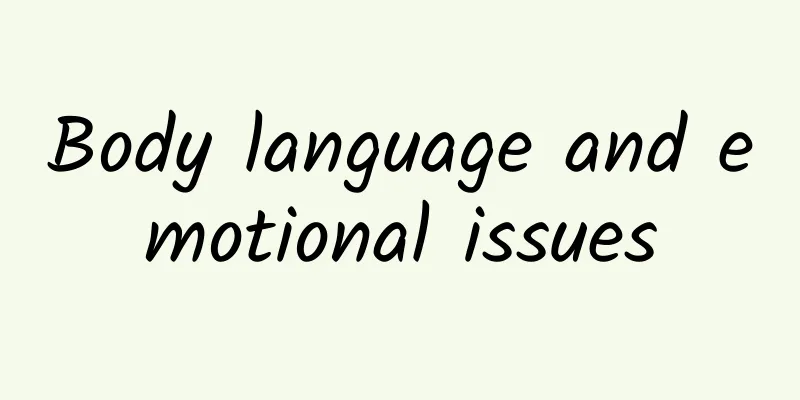Body language and emotional issues

|
Author: Xing Ying Beijing Anding Hospital Affiliated to Capital Medical University Reviewer: Wang Huali, Researcher, National Center for Mental Disorders (Peking University Sixth Hospital) Emotions are the color of life, a unique and recognizable phenomenon in our hearts. The emergence of emotions is the result of the coordinated action of various parts of the body. At the same time, complex and changeable emotions will affect people's physiology, expressions, voices, body language and muscle tension, making people show different body languages when they are in different emotional states. Of course, these body languages can also reasonably express their emotions. Figure 1 Copyright image, no permission to reprint 1. Specific manifestations of emotional changes in the body When our emotions change between fear, anger, tension, sadness, and happiness, our body movements will also change accordingly. If you are frightened or feel afraid or even terrified by something, your whole body may become stiff and your muscle tone may increase. Some people may even have body movements such as trembling, staring blankly or losing their voice. If you are angry about something or someone, most people will unconsciously frown, glare, clench their fists, stiffen their shoulders and neck, and other body movements. When anger reaches a certain level, you may even experience shortness of breath. If you are nervous because of reasons such as attending a job interview or performing on stage, many people will feel a stiff expression, tight throat, increased muscle tension, sweaty palms, and red face. Some people may also stutter, twist their body involuntarily, rub their hands, and pace back and forth. When we feel sad because of the loss of a loved one or encountering a setback, we will sigh and cry. At this time, our eyelids and shoulders will unconsciously droop, and we will become listless and even refuse to communicate with others. When someone is happy because of success or a happy event, they will smile and even dance uncontrollably. At this time, they will feel that their breathing is smooth, their body is as light as a swallow, and they will walk with their head held high. Of course, there are also people who will talk non-stop. Figure 2 Copyright image, no permission to reprint 2. How to reasonably express negative emotions through body language Emotions can be regulated and managed in a variety of ways, among which behavioral communication is an effective way of communication, so the reasonable use of body language to express and relieve negative emotions is a very good choice. When we are angry, we can first do some large-amplitude, fast-speed movements in coordination with our breathing, and then slowly transition to small-amplitude, slow-speed movements. Aerobic exercise, Tai Chi, yoga, etc. are all good choices. When we feel sad, we can spend more time with our loved ones and increase physical contact, such as hugging, holding hands, patting on the back, etc. Physical contact helps increase our sense of security and helps us calm down. Exercise is also a good choice, such as aerobic exercise, relaxation training, breathing training, etc., which are all conducive to calming sad emotions. Figure 3 Copyright image, no permission to reprint 3. Four ways to relieve negative emotions Positive emotions and feelings give people motivation, which can drive them to overcome difficulties, achieve goals, promote balance inside and outside the body, enhance immunity and maintain health. Negative emotions and feelings can hinder people's activities, reduce their vitality, disrupt the brain's nervous system, interfere with normal thinking, reduce the function of the immune system, weaken the body's self-regulation function, destroy the body's internal and external balance, and even damage health. From this point of view, each of us must learn to relieve negative emotions. The specific methods are as follows. (1) You can regulate your emotions through muscle tension emotional dialogue exercises. This is a muscle tension emotional regulation exercise that uses non-verbal communication. When practicing, two people form a group and hold a balloon in one hand. As the balloon moves slowly and randomly, they experience the emotions conveyed by the other person through the balloon and respond accordingly. (2) You can use mind-body breathing regulation exercises to relieve your emotions. This exercise is a self-mind-body regulation relaxation method that alternates between muscle tension and relaxation, and inhalation and exhalation. When you inhale, your muscles tense, and when you exhale, your muscles relax. In the alternation of tension and relaxation, you can slowly regulate your muscle tension and emotions. (3) You can use body perception exercises to regulate your emotions. Body perception exercises are a technique that uses tennis balls or multi-sensory massage balls as a medium. Rehabilitation therapists use special whole-body tapping and pressing techniques to help people integrate their bodies, increase body perception, and relax their bodies and minds. (4) You can regulate your emotions through calm abdominal breathing. Abdominal breathing is a breathing method that is easy to practice at home and is highly practical. When practicing, lie flat on a yoga mat or on a bed and feel the breath circulating in the nasal cavity, chest cavity, abdomen, limbs, and head. Through the circulation of breath, you can bring fresh, comfortable, and beautiful breath into your body and expel turbid, tired, and bad breath from your body. Regulating emotions through breathing has a long history. For example, in the Tang Dynasty, Liu Zongyuan's "Zhongxian Lingbi" mentioned that "it can make you breathe deeply and return to your roots", expressing a state of tranquility and peace. "Breathing deeply" means breathing deeply, expelling the inner restlessness and distracting thoughts from the body, and achieving peace of mind. "Breathing returns to the roots" means that in this state, people can return to their inner selves and return to their true selves. Emotions are a psychological phenomenon that each of us has in our lives due to various needs or desires. Positive emotions make us full of energy, and all our body movements are full of energy, while negative emotions consume our energy and even affect our health. Therefore, when negative emotions appear, remember to use some methods to adjust your mood and relieve bad emotions. |
<<: This article will help you understand pain knowledge and eliminate misunderstandings
>>: Good sleeping habits contribute to the healthy growth of children
Recommend
How to calculate the interval between fetal movements?
What expectant mothers are most concerned about d...
What causes breast tumors?
If a tumor grows on a woman's breast, it may ...
What are the symptoms of pelvic effusion?
Pelvic effusion is a gynecological disease. Somet...
Pimples around nipples when not pregnant
Many friends who have not encountered this kind o...
What to do if a woman has rough skin
Everyone loves beauty, and female friends have ne...
Is it normal to have weak positive after strong positive?
At present, there is a kind of pregnancy test pap...
What is the reason why women's menstruation stops in one day?
Menstruation is a physiological reaction that eve...
What if the hot pot is too spicy and makes my stomach uncomfortable? What should I do if the hot pot is too spicy and makes my stomach uncomfortable?
Many people eat mutton first, then seafood, veget...
Distimo: Report shows that 91% of the world's top 100 companies have released mobile apps
According to an analysis report from Distimo, 91%...
Can patients with uterine fibroids eat red beans?
Can patients with uterine fibroids eat red beans?...
What should I prepare for my baby's first birthday? Why do we have to fight for the first birthday?
Years old is an internationally accepted way to c...
What causes infertility after IUD removal?
After having a baby, many parents will not consid...
What should I do if I have body odor during pregnancy?
Because during pregnancy, you will be more afraid...
Regular uterine contractions disappear in the morning after one night
Everyone knows that having a baby is a very natur...
Why does my stomach hurt when I’m hungry? How to identify and diagnose its symptoms
When many women care about their figure, they alw...









